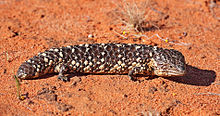Tiliqua rugosa
| Bobtail Skink | |
|---|---|
 |
|
| Eastern Shingleback | |
| Scientific classification | |
| Kingdom: | Animalia |
| Phylum: | Chordata |
| Class: | Reptilia |
| Order: | Squamata |
| Family: | Scincidae |
| Genus: | Tiliqua |
| Species: | T. rugosa |
| Binomial name | |
|
Tiliqua rugosa (Gray, 1825) |
|
| Subspecies | |
|
4, see text |
|
| Synonyms | |
|
Trachydosaurus rugosus |
|
4, see text
Trachydosaurus rugosus
Tiliqua rugosa is a short-tailed, slow moving species of blue-tongued skink found in Australia. Three of the four recognised subspecies are found only in Western Australia, where they are known collectively by the common name bobtail. The name shingleback is also used, especially for T. rugosa asper, the only subspecies native to eastern Australia.
T. rugosa has a heavily armoured body and can be found in various colours, ranging from dark brown to cream. It has a short, wide, stumpy tail that resembles its head and may confuse predators. The tail also contains fat reserves, which are drawn upon during brumation in winter. This skink is an omnivore; it eats snails and plants and spends much of its time browsing through vegetation for food. It is often seen sunning on roadsides or other paved areas.
Apart from bobtail and shingleback, a variety of other common names are used, including stump-tailed skink, bogeye, pinecone lizard and sleepy lizard.
The species was first described by John Edward Gray in 1825 as Trachydosaurus rugosus. It now classified as Tiliqua rugosa. Some herpetologists claim this species has more common names than any other lizard.
Four subspecies of T. rugosa are currently recognized:
The species is widely distributed in arid to semiarid regions of southern and western Australia. The range extends from Shark Bay, Western Australia, across the southern-most regions of the country to the coast, then north into Queensland. Four subspecies are found in Western Australia, including one at Rottnest Island. It also occurs in the eastern states of Victoria and New South Wales, but does not reach coastal areas.
...
Wikipedia
